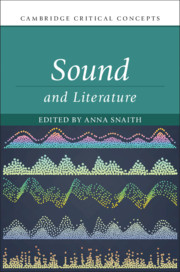Book contents
- Sound and Literature
- Cambridge Critical Concepts
- Sound and Literature
- Copyright page
- Epigraph
- Contents
- Figures
- Contributors
- Acknowledgements
- Introduction
- Part I Origins
- Part II Development
- Part III Applications
- Chapter 10 What We Talk about When We Talk about Talking Books
- Chapter 11 Prose Sense and Its Soundings
- Chapter 12 Dissonant Prosody
- Chapter 13 Deafness and Sound
- Chapter 14 Vibrations
- Chapter 15 Feminism and Sound
- Chapter 16 Wireless Imaginations
- Chapter 17 Attending to Theatre Sound Studies and Complicité’s The Encounter
- Chapter 18 Bob Dylan and Sound: A Tale of the Recording Era
- Bibliography
- Index
Chapter 14 - Vibrations
from Part III - Applications
Published online by Cambridge University Press: 29 May 2020
- Sound and Literature
- Cambridge Critical Concepts
- Sound and Literature
- Copyright page
- Epigraph
- Contents
- Figures
- Contributors
- Acknowledgements
- Introduction
- Part I Origins
- Part II Development
- Part III Applications
- Chapter 10 What We Talk about When We Talk about Talking Books
- Chapter 11 Prose Sense and Its Soundings
- Chapter 12 Dissonant Prosody
- Chapter 13 Deafness and Sound
- Chapter 14 Vibrations
- Chapter 15 Feminism and Sound
- Chapter 16 Wireless Imaginations
- Chapter 17 Attending to Theatre Sound Studies and Complicité’s The Encounter
- Chapter 18 Bob Dylan and Sound: A Tale of the Recording Era
- Bibliography
- Index
Summary
This chapter begins with a brief chronological outline of how vibrations figure in scientific and literary texts from the eighteenth-century to twentieth-century Modernism. It outlines approaches to the transmission of scientific and spiritualist concepts of vibratory energies and atoms through literature, going on to consider literary form and materiality as vibratory, focusing briefly on Conrad’s work. Moving further beyond the confines of literary periods, it then relates analysis of literature in its material forms to the work of music and sound studies scholars who are interested in the materiality of sound as vibration, focusing initially on contemporary bass music, and how it can affect its audience palpably and without linguistic signification. This latter area of research provides pointers for how literary approaches might engage with the materiality of texts and of reading/listening experiences, and, further, with an expanded sense of sound as a form of vibration that extends into the ‘infrasensory’ and operates both within and beyond discourse. The chapter goes on to use Dickens’s fiction to bring together approaches to textual, phenomenological and ontological vibrations. In its sonorous materiality, Dickens’s fiction records an experience of railway vibrations for its readers, while it also conveys a sense of their existence as borderline infrasound and of vibrations that escape perception and discourse.
Keywords
- Type
- Chapter
- Information
- Sound and Literature , pp. 287 - 314Publisher: Cambridge University PressPrint publication year: 2020

